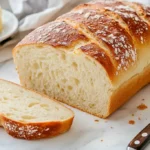Cottage cheese is a versatile ingredient used in many recipes, from breakfast bowls to savory dishes. However, why does cottage cheese get watery when cooked is a common question for many home cooks. The issue of excess moisture can affect the texture and overall outcome of a dish. In this post, we’ll explore the reasons behind this watery separation and share practical tips to prevent and fix it. By understanding the science behind cottage cheese, you can ensure better results in your cooking.

What Happens When Cottage Cheese Gets Watery?
The Role of Curds and Whey in Cottage Cheese
Cottage cheese is made by curdling milk, separating it into curds and whey. These two components play a crucial role in the texture of cottage cheese. Why does cottage cheese get watery when cooked? The answer lies in the relationship between curds and whey. The curds are the solid part, forming the lumpy texture that most people associate with cottage cheese, while the whey is the liquid that remains after curds have developed.
Why does cottage cheese get watery when cooked during the heating process? The moisture content in both the curds and whey shifts. The curds contain water, and this can separate from the rest of the cheese when heated. This often results in a watery texture, especially if the cheese is cooked at high temperatures or for long periods. Understanding why cottage cheese gets watery when cooked helps prevent excess moisture and ensures better texture.
How Heat Affects Cottage Cheese Texture
Cottage cheese’s delicate texture is highly susceptible to changes in temperature. When heated too quickly or at too high a temperature, the moisture within the curds begins to separate. The heat causes the protein structure of the curds to change, which can make the cheese lose its creamy consistency. As a result, cottage cheese may release excess water, resulting in a dish that looks less appetizing and may have an undesirable texture.
To avoid this, it’s important to heat cottage cheese gently. Cooking it at moderate temperatures allows the curds to maintain their structure, preventing excess moisture from escaping. Slow heating helps the cheese retain its creamy texture, making it an excellent addition to a variety of dishes.
Common Cooking Mistakes That Cause Watery Cottage Cheese
Several cooking mistakes can contribute to watery cottage cheese. One of the most common issues is overheating. If cottage cheese is cooked at too high a temperature or for too long, the proteins in the curds will begin to break down, causing them to release moisture.
Another mistake is stirring cottage cheese too aggressively while cooking. Over-stirring can cause the curds to break down and release even more liquid. To avoid this, it is best to handle cottage cheese gently during the cooking process. By recognizing these mistakes and adjusting your cooking techniques, you can prevent the watery texture that often results from cottage cheese being overheated or mishandled.
Many people wonder why certain dairy products aren’t suitable for a low-carb diet. If you’re curious, you can learn more about why cottage cheese is not considered keto in this detailed guide.
Why Does Cottage Cheese Get Watery When Cooked?
The Science Behind Watery Cottage Cheese
Understanding why cottage cheese gets watery when cooked requires a look at the science behind the cheese-making process. Cottage cheese is created by curdling milk using an acid or rennet, which separates the liquid whey from the solid curds. The whey is largely composed of water, lactose, and proteins like casein, which are expelled from the curds during the curdling process.
When cottage cheese is exposed to heat, the proteins in the curds can start to release water. This separation occurs because the proteins in the curds begin to contract and expel moisture. The higher the temperature, the more pronounced this effect can be. If cottage cheese is heated too quickly or for too long, the proteins will release more moisture, making the cheese watery and less creamy.
The Impact of Protein and Fat Content
Cottage cheese comes in various fat contents, ranging from fat-free to full-fat varieties. The protein and fat content in the cheese significantly impact its texture when cooked. High-protein cottage cheeses, such as fat-free or low-fat versions, tend to release more water when heated compared to full-fat varieties. This is because the proteins in low-fat cottage cheese are more concentrated, and they are more likely to break down and release moisture when exposed to heat.
Full-fat cottage cheese, on the other hand, contains more fat, which helps to stabilize the texture during cooking. The fat helps the curds retain their shape and absorb less moisture, resulting in a creamier texture even when heated. If you’re looking to avoid watery cottage cheese, choosing a full-fat version can make a significant difference in the final outcome of your dish.
Differences Between Low-fat and Full-fat Cottage Cheese
The type of cottage cheese you use can also influence how much water is released when cooking. Low-fat cottage cheese tends to have a more delicate structure due to the lower fat content, making it more prone to releasing excess moisture. Full-fat cottage cheese, however, has a creamier, more stable structure, which holds up better during cooking.
While full-fat cottage cheese is often the better choice for cooking, low-fat cottage cheese can still be used effectively if handled with care. For example, if you are cooking a dish that requires high heat, you may want to consider using full-fat cottage cheese to avoid the watery texture that can result from heating low-fat versions. Understanding the differences in fat content can help you make better choices when selecting cottage cheese for cooking.

How to Prevent Cottage Cheese from Getting Watery
Tips for Cooking Cottage Cheese Properly
To prevent cottage cheese from getting watery when cooked, it’s essential to cook it at the right temperature. Heating cottage cheese slowly and gently ensures that the curds maintain their shape and moisture. Here are some key tips for cooking cottage cheese properly:
- Use low to medium heat: High heat can cause cottage cheese to release moisture quickly, resulting in a watery texture. Always cook cottage cheese on low to medium heat.
- Avoid boiling: Boiling cottage cheese can cause the proteins to break down, making the cheese watery. Instead, gently heat it until it’s warm.
- Stir gently: Over-stirring cottage cheese can break the curds and cause them to release more water. Stir gently to preserve the texture.
By following these simple guidelines, you can keep your cottage cheese creamy and prevent the watery texture that often occurs when it is cooked improperly.
Before adding dairy to your meal plan, it’s essential to understand why cottage cheese is not keto-friendly and how it can impact your carb intake.
Choosing the Right Type of Cottage Cheese
Not all cottage cheese is created equal, and the type you choose can make a big difference in the outcome of your dish. When preparing cottage cheese for cooking, choose a version that is appropriate for your recipe. For instance, if you are making a savory dish like lasagna or a casserole, full-fat, small-curd cottage cheese is an excellent option.
Full-fat cottage cheese retains more moisture and results in a creamier texture, even when cooked. Small-curd cottage cheese is also preferable for dishes where you want a smoother consistency. Large-curd cottage cheese can be a bit more prone to releasing moisture, so it’s best used in dishes where the texture won’t be as important.
Use in Recipes: When to Add Cottage Cheese
In many recipes, the timing of when cottage cheese is added can affect its texture. To prevent it from becoming watery, add cottage cheese at the end of the cooking process. If it’s added too early, it will likely cook for too long and release excess water.
For dishes like casseroles, adding cottage cheese in the final few minutes of cooking will help it stay creamy without becoming too watery. If you are making a hot dish that requires cottage cheese, consider adding it near the end to preserve its texture.
How to Fix Watery Cottage Cheese After Cooking
Straining Excess Water
If your cottage cheese becomes watery after cooking, don’t worry—there are several ways to fix it. One effective method is to strain out the excess water. Use a fine mesh strainer or cheesecloth to remove the whey from the curds. This process will help restore the creamy texture and reduce the watery appearance.
After straining the excess liquid, you can gently reincorporate the curds to bring back the cottage cheese’s original texture. This simple technique can help salvage a dish that might have otherwise been ruined by watery cottage cheese.
Reincorporating the Curds and Whey
If the curds and whey have separated, you can try reincorporating them. To do this, gently mix the curds back together with the whey. This can help redistribute the moisture and restore the cottage cheese’s original consistency. However, be cautious when doing this, as stirring too aggressively can break the curds and make the texture worse.
If the texture still feels too watery after reincorporation, you can strain it once more to remove any remaining excess liquid.
Using Cottage Cheese in Other Recipes
Even if cottage cheese becomes watery, it doesn’t have to be wasted. There are plenty of recipes where slightly watery cottage cheese can still be used effectively. For example, you can incorporate watery cottage cheese into smoothies, baked goods, or creamy dips. The moisture will blend into the dish, and the flavor will still remain intact.
Alternatively, you can use watery cottage cheese in savory dishes where the texture won’t be as noticeable. For example, cottage cheese can be added to pasta sauces or soups, where the moisture can enhance the overall flavor.
For those following a low-carb lifestyle, it’s helpful to read about why cottage cheese doesn’t align with keto diets to make informed choices.

Health and Nutritional Considerations of Watery Cottage Cheese
Nutritional Benefits of Cottage Cheese
Cottage cheese is a highly nutritious dairy product. It’s an excellent source of protein, which is essential for muscle growth and repair. Cottage cheese is also rich in calcium, which supports bone health, and it contains a range of vitamins and minerals that contribute to overall health. Additionally, it’s a good source of probiotics, which can support digestive health.
Despite its watery appearance when heated, cottage cheese remains a healthy choice for many dishes. Whether you prefer it as a snack or as part of a meal, cottage cheese can provide numerous nutritional benefits.
Does Watery Cottage Cheese Affect Nutrition?
While the texture of cottage cheese may change when cooked, the nutritional content remains largely unaffected. The protein, calcium, and other essential nutrients remain in the curds and whey, even if the cheese releases excess water during cooking. Therefore, watery cottage cheese will still provide the same nutritional benefits as its creamy counterpart.
However, the texture of the cheese can impact the taste and experience of the dish. While watery cottage cheese still has the same nutritional value, it may not be as enjoyable to eat in some recipes. Understanding how to manage the texture can enhance the overall eating experience.
Alternatives to Cottage Cheese in Recipes
If watery cottage cheese is an issue, there are plenty of alternatives you can use in recipes. For example, ricotta cheese is a good substitute that provides a similar texture without the risk of becoming too watery when cooked. Greek yogurt is another option that offers creaminess and a thicker consistency, especially in savory dishes.
Other dairy products, such as mascarpone or cream cheese, can also be used in place of cottage cheese. These substitutes may offer slightly different flavors but can still help achieve the desired texture in your dish.
FAQs
What happens to cottage cheese when you cook it?
When cottage cheese is heated, the moisture content in the curds and whey separates, causing the cheese to become watery. The heat breaks down the proteins and changes the structure of the curds, releasing more whey. Overheating or cooking cottage cheese for too long can intensify this effect, making it appear runny or watery. To prevent this, it’s important to use gentle heat and avoid overcooking.
How do you make cottage cheese less watery?
To reduce the water content of cottage cheese, you can strain it using a fine mesh strainer or cheesecloth to remove excess whey. Another method is to place cottage cheese in the fridge for a few hours, allowing the liquid to separate naturally before draining it. Alternatively, you can cook it at lower temperatures, which helps retain the moisture balance and keeps the curds intact. Opting for full-fat cottage cheese may also help, as it tends to be creamier and less prone to excess moisture.
What makes cottage cheese wet?
Cottage cheese is naturally wet due to its composition, which consists of curds and whey. The whey is the liquid part of the cheese, and its presence gives cottage cheese its wet consistency. Factors like the fat content of the cheese, how long it’s been drained, and whether it’s been stored properly can influence how wet the cottage cheese is. Additionally, heating or stirring it can cause the whey to separate further, making the cheese appear even wetter.
Why is my blended cottage cheese runny?
Blended cottage cheese becomes runny because blending breaks down the curds, which releases more moisture. The process of blending causes the curds to lose their structure and allows the whey to mix with the rest of the cheese, resulting in a thinner texture. If you want to prevent this, try using a gentler blending method, or add other ingredients, such as yogurt or sour cream, to thicken the mixture. Additionally, using full-fat cottage cheese can help maintain a creamier consistency when blended.
Conclusion
In conclusion, cottage cheese can become watery when cooked due to the separation of moisture in the curds and whey. This is influenced by factors like cooking temperature, protein and fat content, and the type of cottage cheese used. By understanding the science behind watery cottage cheese and following proper cooking techniques, you can prevent this issue and enjoy a creamy, smooth texture.
If watery cottage cheese does occur, don’t worry—there are several methods to fix it, such as straining the excess water or reincorporating the curds. Additionally, knowing when to add cottage cheese to your recipes and choosing the right type of cottage cheese can help prevent excess moisture.
By following these tips, you can confidently cook with cottage cheese and avoid the frustration of watery results. Try experimenting with different methods to find the best texture for your dishes.










1 thought on “Why Cottage Cheese Gets Watery When Cooked and How to Fix It”